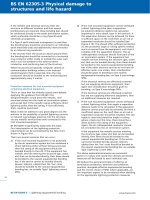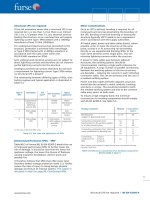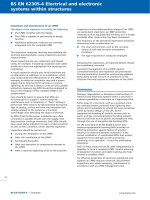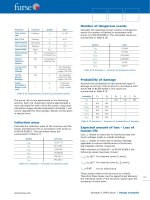Bsi bs en 01382 2016
Bạn đang xem bản rút gọn của tài liệu. Xem và tải ngay bản đầy đủ của tài liệu tại đây (1.19 MB, 14 trang )
BS EN 1382:2016
BSI Standards Publication
Timber Structures — Test
methods — Withdrawal
capacity of timber fasteners
BS EN 1382:2016
BRITISH STANDARD
National foreword
This British Standard is the UK implementation of EN 1382:2016. It
supersedes BS EN 1382:1999 which is withdrawn.
The UK participation in its preparation was entrusted to Technical
Committee B/518, Structural timber.
A list of organizations represented on this committee can be
obtained on request to its secretary.
This publication does not purport to include all the necessary
provisions of a contract. Users are responsible for its correct
application.
© The British Standards Institution 2016. Published by BSI Standards
Limited 2016
ISBN 978 0 580 85799 7
ICS 91.080.20
Compliance with a British Standard cannot confer immunity from
legal obligations.
This British Standard was published under the authority of the
Standards Policy and Strategy Committee on 29 February 2016.
Amendments issued since publication
Date
Text affected
BS EN 1382:2016
EN 1382
EUROPEAN STANDARD
NORME EUROPÉENNE
EUROPÄISCHE NORM
February 2016
ICS 91.080.20
Supersedes EN 1382:1999
English Version
Timber Structures - Test methods - Withdrawal capacity of
timber fasteners
Structures en bois - Méthodes d'essai - Résistance à
l'arrachement dans le bois d'éléments de fixation
Holzbauwerke - Prüfverfahren - Ausziehtragfähigkeit
von Holzverbindungsmitteln
This European Standard was approved by CEN on 19 December 2015.
CEN members are bound to comply with the CEN/CENELEC Internal Regulations which stipulate the conditions for giving this
European Standard the status of a national standard without any alteration. Up-to-date lists and bibliographical references
concerning such national standards may be obtained on application to the CEN-CENELEC Management Centre or to any CEN
member.
This European Standard exists in three official versions (English, French, German). A version in any other language made by
translation under the responsibility of a CEN member into its own language and notified to the CEN-CENELEC Management
Centre has the same status as the official versions.
CEN members are the national standards bodies of Austria, Belgium, Bulgaria, Croatia, Cyprus, Czech Republic, Denmark, Estonia,
Finland, Former Yugoslav Republic of Macedonia, France, Germany, Greece, Hungary, Iceland, Ireland, Italy, Latvia, Lithuania,
Luxembourg, Malta, Netherlands, Norway, Poland, Portugal, Romania, Slovakia, Slovenia, Spain, Sweden, Switzerland, Turkey and
United Kingdom.
EUROPEAN COMMITTEE FOR STANDARDIZATION
COMITÉ EUROPÉEN DE NORMALISATION
EUROPÄISCHES KOMITEE FÜR NORMUNG
CEN-CENELEC Management Centre: Avenue Marnix 17, B-1000 Brussels
© 2016 CEN
All rights of exploitation in any form and by any means reserved
worldwide for CEN national Members.
Ref. No. EN 1382:2016 E
BS EN 1382:2016
EN 1382:2016 (E)
Contents
Page
European foreword....................................................................................................................................................... 3
1
Scope .................................................................................................................................................................... 4
2
Normative references .................................................................................................................................... 4
3
Terms and definitions ................................................................................................................................... 4
4
Symbols and abbreviations ......................................................................................................................... 5
5
5.1
5.2
Materials............................................................................................................................................................. 6
Timber................................................................................................................................................................. 6
Fasteners ............................................................................................................................................................ 6
6
6.1
6.2
6.3
6.3.1
6.3.2
6.4
6.5
6.6
Test methods .................................................................................................................................................... 6
General ................................................................................................................................................................ 6
Conditioning...................................................................................................................................................... 6
Fabrication of the specimens ...................................................................................................................... 7
Fastener axis perpendicular to the grain ............................................................................................... 7
Fastener axis parallel to the grain ............................................................................................................ 7
Test procedure ................................................................................................................................................. 8
Test results ........................................................................................................................................................ 8
Test report ......................................................................................................................................................... 9
Bibliography ................................................................................................................................................................. 10
2
BS EN 1382:2016
EN 1382:2016 (E)
European foreword
This document (EN 1382:2016) has been prepared by Technical Committee CEN/TC 124 “Timber
Structures”, the secretariat of which is held by AFNOR.
This European Standard shall be given the status of a national standard, either by publication of an
identical text or by endorsement, at the latest by August 2016, and conflicting national standards shall
be withdrawn at the latest by August 2016.
Attention is drawn to the possibility that some of the elements of this document may be the subject of
patent rights. CEN [and/or CENELEC] shall not be held responsible for identifying any or all such patent
rights.
This document will supersede EN 1382:1999.
Compared to EN 1382:1999, the following changes have been made:
— replacement of EN 28970 by EN ISO 8970;
— improvement to figures and to definitions.
According to the CEN-CENELEC Internal Regulations, the national standards organizations of the
following countries are bound to implement this European Standard: Austria, Belgium, Bulgaria,
Croatia, Cyprus, Czech Republic, Denmark, Estonia, Finland, Former Yugoslav Republic of Macedonia,
France, Germany, Greece, Hungary, Iceland, Ireland, Italy, Latvia, Lithuania, Luxembourg, Malta,
Netherlands, Norway, Poland, Portugal, Romania, Slovakia, Slovenia, Spain, Sweden, Switzerland,
Turkey and the United Kingdom.
3
BS EN 1382:2016
EN 1382:2016 (E)
1 Scope
This European Standard specifies the test method for determining the withdrawal capacity of fasteners
which have been inserted into timber (solid timber, LVL, CLT and glued laminated timber).
The test method applies to all types of nails, screws and staples.
2 Normative references
The following documents, in whole or in part, are normatively referenced in this document and are
indispensable for its application. For dated references, only the edition cited applies. For undated
references, the latest edition of the referenced document (including any amendments) applies.
EN 14592, Timber structures - Dowel-type fasteners – Requirements
EN 26891:1991, Timber structures - Joints made with mechanical fasteners - General principles for the
determination of strength and deformation characteristics (ISO 6891:1983)
EN ISO 8970:2010, Timber structures - Testing of joints made with mechanical fasteners - Requirements
for wood density (ISO 8970:2010)
ISO 13061-1, Physical and mechanical properties of wood — Test methods for small clear wood
specimens — Part 1: Determination of moisture content for physical and mechanical tests
ISO 13061-2, Physical and mechanical properties of wood — Test methods for small clear wood
specimens — Part 2: Determination of density for physical and mechanical tests
3 Terms and definitions
For the purposes of this document, the following terms and definitions apply.
3.1
staple
double-bent, u-shaped piece of round, square, rectangular or oval wire with pointed legs
3.2
staple crown
connection between the two staple legs
3.3
staple leg diameter
nominal value of the diameter of a round staple leg, the side length of a rectangular leg, or the diameter
of an oval cross section as defined in EN 14592
3.4
staple length
length of each staple leg, including point
3.5
staple crown width
width across the staple legs
4
BS EN 1382:2016
EN 1382:2016 (E)
3.6
withdrawal parameter
parameter measuring the resistance of a timber test piece to the withdrawal of a timber fastener
Note 1 to entry
Figure 1 is given for clarification purposes.
4 Symbols and abbreviations
For the purposes of this document, the following symbols and abbreviations apply.
For symbols relating to staples.
a
d
staple crown width, see Figure 1, in millimetres
Fmax
maximum withdrawal load, in newtons
l
fax
ld
αcrn
is the outer thread diameter for screws, the diameter of the smooth plain part of a round nail or for staples
the diameter of the wire (transformed to around cross-section), see EN 14592
is the fastener length, or leg length of the staple
withdrawal parameter, in newtons per square millimetres
the effective depth of penetration of the fastener, in millimetres. For smooth nails and staples this includes
the point. For profiled nails only the penetration depth of the profiled, for screws only the penetration
depth of the profiled. In the case of partly or completely resin coated fasteners only the penetration depth
of the coated part
angle between the direction of a staple crown and the grain direction, respectively, see Figure 2, in
degrees.
Key
l
d
a
is fastener length
is diameter
is staple crown width
Figure 1 — Staple nail and screw dimensions
5
BS EN 1382:2016
EN 1382:2016 (E)
Key
1
grain direction
Figure 2 — Angle between the staple direction and the grain direction
5 Materials
5.1 Timber
The solid timber shall be selected in accordance with the method given in EN ISO 8970:2010.
The specification of the LVL, CLT and glued laminated timber shall be established. The products used
for the individual test pieces shall be representative of the class or range of product to which they
belong and the relevant properties shall be declared.
5.2 Fasteners
The specification of nails, screws or staples shall be established.
6 Test methods
6.1 General
The moisture content and density of the timber at test shall be determined as specified in ISO 13061-1
and ISO 13061-2 as appropriate.
6.2 Conditioning
For smooth fasteners the test pieces shall be manufactured with the timber or wood-based products at
an equilibrium moisture content corresponding to (20 ± 2) °C and (85 ± 5) % relative humidity.
After manufacture the test pieces shall be stored for at least one week at (20 ± 2) °C and (65 ± 5) %
relative humidity.
For all other fasteners the test pieces shall be manufactured with the timber or wood-based products at
an equilibrium moisture content corresponding to (20 ± 2) °C and (65 ± 5) % relative humidity.
After manufacture the test pieces shall be stored at (20 ± 2) °C and (65 ± 5) % relative humidity until it
is conditioned.
6
BS EN 1382:2016
EN 1382:2016 (E)
The material is conditioned when it attains constant mass. Constant mass is considered to be attained
when, the results of two successive weightings, carried out at an interval of 6 h, do not differ by more
than 0,1 % of the mass of the material.
For certain investigations other moisture conditioning may be appropriate, and shall be reported.
NOTE
For some deciduous wood species a much longer storing period may be necessary.
6.3 Fabrication of the specimens
6.3.1 Fastener axis perpendicular to the grain
The axis of the fastener shall be perpendicular to the timber surface. The insertion of fasteners shall
follow normal preparation (e.g. pre-boring) and practice. The width and depth of the test piece in the
direction of insertion of the fastener shall be at least (l + 5d), see Figure 3. Where the test pieces are of
solid timber the insertion shall be ad random with respect to the growth rings. For LVL the direction
can be taken as perpendicular to the laminated veneer sheets. For staples, the tests shall be carried out
with an angle of αcrn = 30°.
The other dimensions of the test piece shall comply with Figure 3. The fasteners shall be driven to a
penetration of between 8 d and 20 d and shall be positioned as shown.
NOTE
The range of depth penetration is given so that the depth of penetration used in the test can be decided
depending on the withdrawal resistance and the tensile capacity of the fastener. A depth of penetration of at least
12 d is appropriate to fasteners of d less than 2 mm.
Figure 3 — Withdrawal timber test pieces - load perpendicular to grain
6.3.2 Fastener axis parallel to the grain
The axis of the fastener shall be perpendicular to the timber surface. The insertion of fasteners shall
follow normal preparation (e.g. pre-boring) and practice. The length of the test piece in the direction of
insertion of the fastener shall be at least (2l + 5d), see Figure 4.
NOTE 1
This test method can also be used with the fasteners inserted into the timber at angles of between 0°
and 90° to the grain direction.
The other dimensions of the test piece shall comply with Figure 4. The fasteners shall be driven into the
end grain to a penetration of between 8 d and 20 d and shall be positioned as shown.
NOTE 2
A depth of penetration of at least 12 d is appropriate to fasteners of d less than 2 mm.
7
BS EN 1382:2016
EN 1382:2016 (E)
Figure 4 — Withdrawal test pieces - load parallel to grain
6.4 Test procedure
The apparatus used shall be as required in Clause 7 of EN 26891:1991. Determine the depth of the
fastener penetration ld. Place the test piece in a device ensuring the application of the withdrawal force
along the axis of the fastener or the axes of the staple legs. Any part of the supports shall be not closer to
the axis of the fastener than 3 d for nails and screws and a for staples.
The withdrawal test shall be performed with a constant rate of loading. When determining the
withdrawal parameter fax, the rate of loading shall be such that the time taken to reach Fmax is (60 ± 15)
s. Determine Fmax to an accuracy of 1 %.
6.5 Test results
The withdrawal capacity is equal to the withdrawal load Fmax.
The withdrawal parameter, fax, shall be determined from the equations:
f ax =
Or
f ax =
Fmax
, for nails or screws
d × ld
Fmax
, for staples
d × 2l d
The symbols are as given in Clause 4.
8
BS EN 1382:2016
EN 1382:2016 (E)
6.6 Test report
The test report shall contain the following information:
a) sampling procedure;
b) specification of the timber;
c) dimensions, density, moisture content and conditioning history of the test pieces, fissures if any;
d) diagram showing the layout of the fasteners and the method of insertion used in the test pieces;
e) angle, αcrn, between staple crown and grain as used in the test;
f)
number of test pieces used;
g) specification and number of fasteners tested (type, sizes, material, surface coating or condition and
other particulars);
h) time to failure;
i)
individual test results for the withdrawal parameter fax and the withdrawal capacity Fmax, mean
values and standard deviations, and description of the mode of failure.
NOTE
Characteristic values can be determined using EN 14358.
9
BS EN 1382:2016
EN 1382:2016 (E)
Bibliography
[1]
[2]
10
EN 1381, Timber structures - Test methods - Load bearing stapled joints
EN 14358, Timber structures - Calculation of characteristic 5-percentile values and acceptance
criteria for a sample
This page deliberately left blank
NO COPYING WITHOUT BSI PERMISSION EXCEPT AS PERMITTED BY COPYRIGHT LAW
British Standards Institution (BSI)
BSI is the national body responsible for preparing British Standards and other
standards-related publications, information and services.
BSI is incorporated by Royal Charter. British Standards and other standardization
products are published by BSI Standards Limited.
About us
Revisions
We bring together business, industry, government, consumers, innovators
and others to shape their combined experience and expertise into standards
-based solutions.
Our British Standards and other publications are updated by amendment or revision.
The knowledge embodied in our standards has been carefully assembled in
a dependable format and refined through our open consultation process.
Organizations of all sizes and across all sectors choose standards to help
them achieve their goals.
Information on standards
We can provide you with the knowledge that your organization needs
to succeed. Find out more about British Standards by visiting our website at
bsigroup.com/standards or contacting our Customer Services team or
Knowledge Centre.
Buying standards
You can buy and download PDF versions of BSI publications, including British
and adopted European and international standards, through our website at
bsigroup.com/shop, where hard copies can also be purchased.
If you need international and foreign standards from other Standards Development
Organizations, hard copies can be ordered from our Customer Services team.
Subscriptions
Our range of subscription services are designed to make using standards
easier for you. For further information on our subscription products go to
bsigroup.com/subscriptions.
With British Standards Online (BSOL) you’ll have instant access to over 55,000
British and adopted European and international standards from your desktop.
It’s available 24/7 and is refreshed daily so you’ll always be up to date.
You can keep in touch with standards developments and receive substantial
discounts on the purchase price of standards, both in single copy and subscription
format, by becoming a BSI Subscribing Member.
PLUS is an updating service exclusive to BSI Subscribing Members. You will
automatically receive the latest hard copy of your standards when they’re
revised or replaced.
To find out more about becoming a BSI Subscribing Member and the benefits
of membership, please visit bsigroup.com/shop.
With a Multi-User Network Licence (MUNL) you are able to host standards
publications on your intranet. Licences can cover as few or as many users as you
wish. With updates supplied as soon as they’re available, you can be sure your
documentation is current. For further information, email
BSI Group Headquarters
389 Chiswick High Road London W4 4AL UK
We continually improve the quality of our products and services to benefit your
business. If you find an inaccuracy or ambiguity within a British Standard or other
BSI publication please inform the Knowledge Centre.
Copyright
All the data, software and documentation set out in all British Standards and
other BSI publications are the property of and copyrighted by BSI, or some person
or entity that owns copyright in the information used (such as the international
standardization bodies) and has formally licensed such information to BSI for
commercial publication and use. Except as permitted under the Copyright, Designs
and Patents Act 1988 no extract may be reproduced, stored in a retrieval system
or transmitted in any form or by any means – electronic, photocopying, recording
or otherwise – without prior written permission from BSI. Details and advice can
be obtained from the Copyright & Licensing Department.
Useful Contacts:
Customer Services
Tel: +44 845 086 9001
Email (orders):
Email (enquiries):
Subscriptions
Tel: +44 845 086 9001
Email:
Knowledge Centre
Tel: +44 20 8996 7004
Email:
Copyright & Licensing
Tel: +44 20 8996 7070
Email:









